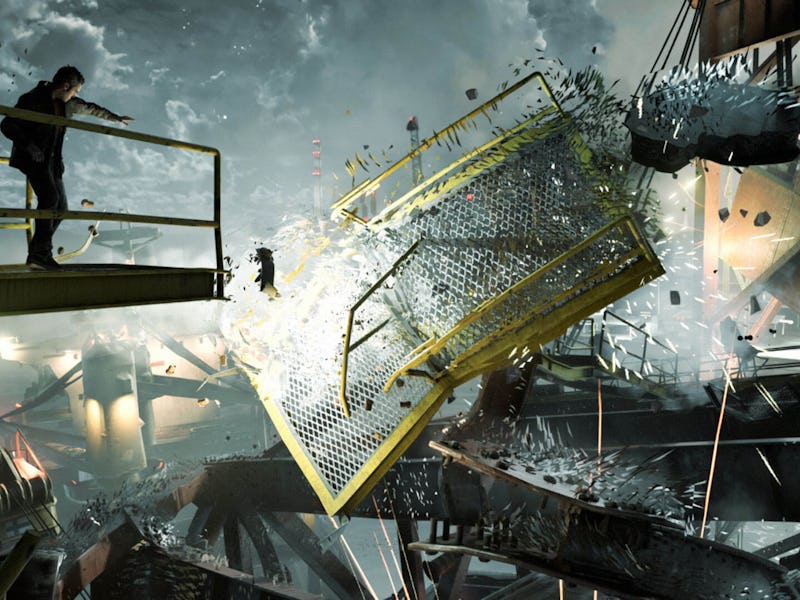6 years later, the most underrated time travel game deserves a sequel
Time is Power.

Time travel stories always run the risk of falling into a gaping plot hole so big that it totally destroys the narrative. Between paradoxes and nuanced theories of space-time, things can go off the rails rather easily — even more so in video games.
Remedy Entertainment’s 2016 game, Quantum Break, assumes that the past cannot be changed, incorporating the Novikov self-consistency principle. This foundational theory leads to some of the most satisfying and airtight time travel rules ever represented in a video game.
Quantum Break follows a young man named Jack Joyce as he assists his friend Paul Serene in a time travel experiment at a university that goes completely wrong. Paul’s time machine malfunctions, causing a Fracture that randomly desynchronizes time itself and produces Stutters, where time becomes frozen for short periods.
The resulting explosion from the time machine infects both Paul and Jack with Chronon particles, giving them different time-based abilities. Paul gets flung into the far future into “The End of Time” where time has collapsed into a singularity because of the Fracture.
Yeah. It’s a lot.
The Rules of Time Travel is an Inverse special issue exploring the evolution of science fiction's most imaginative sub-genre. From Marty McFly to Avengers: Endgame.
Quantum Break has incredibly consistent time travel rules that make its story believable.
Shortly after, Paul returns to the present day notably older and with full control over his time travel powers. This older version is also the founder of Monarch Solutions, a corporation that specializes in time-travel technology, and its soldiers are Jack’s enemies throughout the game.
Armed with the knowledge of the past, present, and future, Paul accepts that the End of Time is inevitable. In contrast, Jack believes that he can change events in the past to prevent the End of Time from ever happening.
Jack and Paul spend the entire game at odds with one another as they travel through time in search of the Countermeasure, a device that can theoretically repair the Fracture or even counteract the effects of The End of Time.
“It proves that the game's writers had a hardcore appreciation for reflecting on some of the most mind-bending theories in physics.”
Quantum Break does a fantastic job dramatizing the Schrödinger's cat thought experiment about quantum superposition where unperceived objects exist in a state of flux, meaning that unless we confirm whether or not a cat inside a box is dead, said cat is both at the same time.
In one of the game's biggest twists, Quantum Break presents a major character's presumed death, but if we don’t perceive it, does it really happen? We won't spoil the details here, but rest assured it's a compelling use of the concept for storytelling purposes. It proves that the game's writers had a hardcore appreciation for some of the most mind-bending theories in physics.
Additionally, the game emphasizes the concept of determinism, meaning that everything happens for a reason, and there’s no way to change the future. While Jack may think he is influencing the past to change the future, it seems increasingly more likely as the game progresses that his destiny is unavoidable.
The game also has something called Junction Points after every chapter where you choose between two different paths for a character. In one of these, Paul puts his trust into either of two people, and your choice affects what kind of cutscene you see next. Each outcome leads to some interesting character development but doesn’t actually change the overall direction of the story. This context actually makes sense because it adds to the overall narrative that each individual decision isn’t enough to change fate: The End of Time.
Quantum Break’s main cast of characters all have a role to play in the story.
Quantum Break’s time travel logic is so consistent that the game’s ending, however complex, is immensely satisfying. Big spoilers are incoming, but after Paul is defeated, Jack is offered a position at Monarch Solutions. The game ends on a Junction Point cliffhanger where Jack can see two possible futures. In one, it looks like he accepts the offer, and in the other, it looks like he rejects it. So there’s definitely potential for a sequel that explores one or both possibilities.
But will a sequel ever happen? That’s up in the air for now. While Microsoft said that the game exceeded sales expectations, the company hasn’t seemed to greenlight one yet. Remedy Entertainment said that any approval for sequels for Alan Wake or Quantum Break would be up to Microsoft. However, in 2019, Remedy eventually acquired the publishing rights for Alan Wake, and now Alan Wake 2 is in development.
As for Quantum Break, it seems like Microsoft still retains the publishing rights to the IP. The game got generally positive reviews, so a sequel might be possible someday. Many reviewers had gripes about Quantum Break, including its repetitive gameplay and the tacked-on live TV show component.
However, if Remedy can improve on the gameplay beyond the generic third-person shooter action, the sequel could be something special — especially because the storytelling, lore, and characters are already rock solid. It’s a great-looking game, and a strong narrative-driven title would be a boon to Microsoft's exclusive portfolio. At the very least, Quantum Break will remain one of the best time travel games of all time.
Quantum Break is available for purchase on Xbox One and PC. The game is also available on Xbox Game Pass.
This article was originally published on